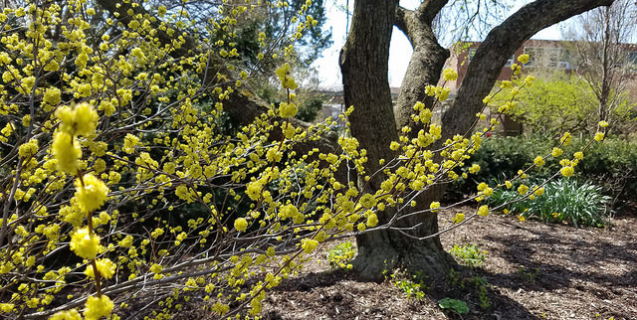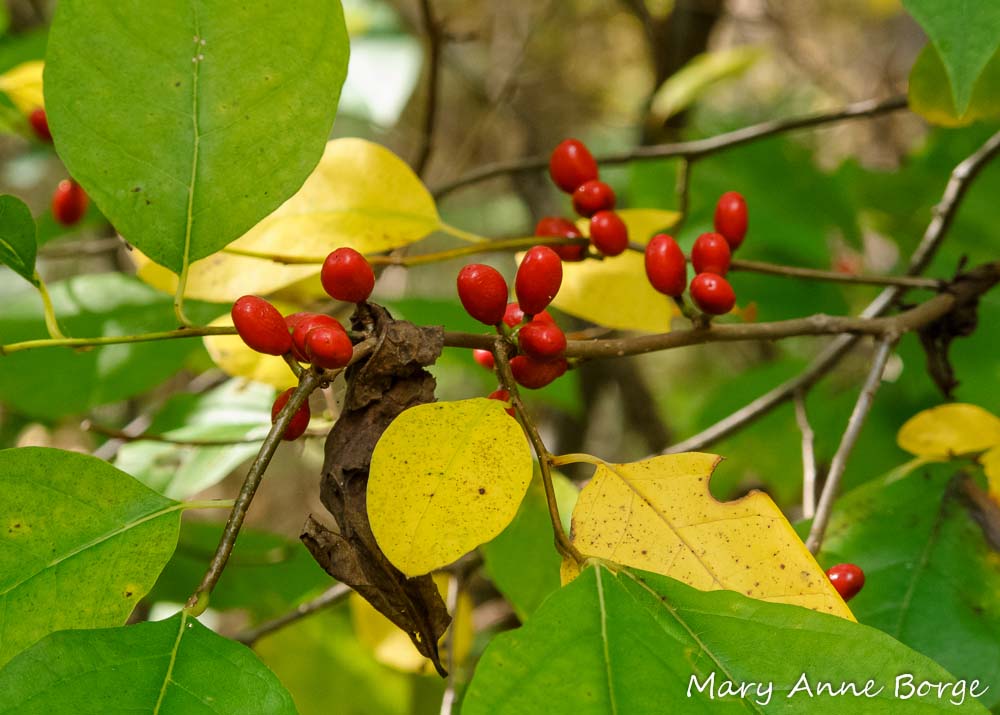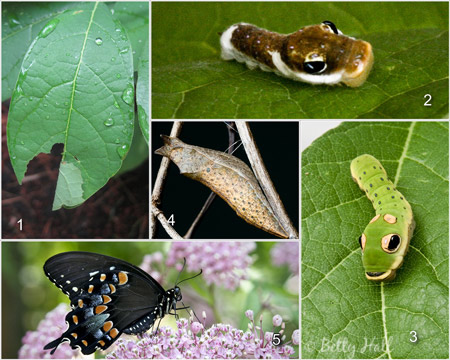Frequent readers of this blog know that I’ve been trying to figure out what plants will not destroy a retaining wall – not only because of the one we had to rebuild last summer next to our driveway [1] but also because of the one in our backyard, where there is currently a rapidly deteriorating fence.[2] My original plan (going back several years) was to remove the fence entirely and plant forsythia in its place. There is a large forsythia hedge around the backyard at my parents’ house, so I have a certain level of nostalgia for the plant, especially in the spring when it bursts into yellow.
I also know it is easy to propagate, and it fills in empty spaces by sending up shoots, or suckers, nearby. Since I was looking for something that didn’t have a robust, woody root system (like the tree that had just toppled the driveway wall), a suckering plant seemed like it might be a good idea. Unfortunately, there was one big problem with forsythia: it’s not native. Now, that isn’t a problem for everyone, and while it is aggressive, it isn’t considered invasive in Pennsylvania.[3] I still love it, and I’m not going to get rid of the little bit we have in another corner of our property, but I really don’t want to plant more when I could be choosing something native instead.

Image credit: [4]
Prioritizing native plants in your landscaping choices is beneficial for many reasons, whether you want to make finding nutritious food easier for native birds, butterflies, bees, and other pollinators, or whether you just want to make it easier on yourself because native plants require less maintenance once they’re established.[5] A healthy population of native plants in your yard will also help limit opportunities for invasive species to move in. While I’ve made a ton of progress building native plant populations in my front yard, I’m still very much in the “rip everything out” phase in the back – where I want to put this hedge.
Analysis Paralysis
For the record, I am not here to judge your gardening choices; just to provide information that might be helpful should you want to add some native beauty to your yard and support your friendly neighborhood pollinators. To help grow my own knowledge base, about a year or two ago I joined a Facebook group for people who want to plant natives in their gardens. In that group I learned a little bit of useful information about the benefits of native plants and – as you might expect from any Facebook group – saw a lot of judgment for people who don’t have them.
Some online forums had suggestions about what to plant near retaining walls, but I trust very little online information these days, especially when I can’t corroborate it from multiple expert sources. And no one seemed to have consistent advice, if any advice at all, for native hedges near hardscapes. Feeling very much on my own, I started working my way through the Audubon Society’s list of plants that are native to Western Pennsylvania, marking down any relevant characteristics, including mature height, growth habit, root type, and soil preferences.[6] There weren’t many options that seemed like a good fit, and I began to get discouraged. I just wasn’t sure where to draw the line between plant preferences and requirements, and the last thing I wanted to do was plant something where it wouldn’t thrive. Fortunately, I have some experts in the family.

Image credit: [7]
When I was back home for Easter this year, I asked my aunt and uncle (who have a garden center [8] and an encyclopedic knowledge of plants) about my options. I described what I had read last summer about needing something with roots that wouldn’t push the retaining wall blocks out of place, that would be tolerant of high pH levels because of the limestone behind the wall, and that could handle lower moisture levels because a well-constructed wall should have proper drainage.[9],[10] I could see them both thinking through options, developing ideas in their heads, and then I added the most important criteria: I wanted something native. At that point, their expressions collapsed along with their mental lists.
I explained that I had come across a couple possible options, but I wasn’t sure if they – or the wall – would survive. At the top of my list were various types of shrubby dogwoods,[11] various types of viburnums,[12] and spicebush.[13] Ultimately we landed on the spicebush – and by “we,” I mean that I basically asked them if my very obvious preference would work. Since the spicebush is commonly found in low lying areas and along water sources, I worried that it would dry out on top of a retaining wall, but its root system is fibrous enough that it might not pose too much of a danger to the wall itself, and my hope was that rain runoff from our patio slab would keep the soil more moist than it would be otherwise.
Lindera benzoin
I do know that I have a bad habit of believing that something will work if I just want it enough – vestiges of being a spoiled only child. And I am aware that I probably railroaded the conversation with my aunt and uncle just a bit, ultimately asking if they could tell me whether they thought it was a bad idea. After hours of online research and a lengthy conversation with the two people I trust most about plants, I’m not sure there is a good option for what I want to do, but I will be moving forward with my plan, having at least a reasonable assurance that it won’t be a complete disaster.

Image credit: [14]
And, ironically, spicebush first came to my attention in that native plants Facebook group after someone asked for recommendations on a good native substitute… for forsythia. Maybe spicebush just imprinted on me at that point, but I think I am also especially excited about the prospect of having 30 feet of spicebush hedge along my back patio. Like forsythia, it has yellow buds in the spring, but that is where forsythia’s visual interest ends. In the fall, the green leaves turn yellow, and female spicebush plants develop red berries (as long as there is a male plant nearby). Maybe most exciting is that spicebush is the host plant for the spicebush swallowtail and remains one of the few plants that swallowtail larvae can eat.
I’ve been incredibly excited by the idea that several years from now I might be sitting on my back porch, next to a fully grown spicebush hedge, with black and blue butterflies flitting around their favorite plant… that I might be able to cook or brew with some of the leaves, bark, or berries, which resemble allspice in flavor… [15] that I will eventually successfully eradicate everything else currently growing so prolifically along that wall, such as pokeweed and Canada thistle… and, most importantly, that I will be able to find some spicebush to plant this year! It seems I’m not the only one who has discovered this amazing plant, and it has become much more popular (and had sold out when last I checked) at some of my go-to nurseries.
There will be much more news to come in the future as I demolish the fence, dig up the weeds, get the spicebush plants in place, and fend off our local fauna that might want to make them a snack. For the time being, I remain cautiously optimistic, if not excited, about what’s to come.
~
Do you have any experience with spicebush? What has worked (or not) for you? Please share your stories below.
Thanks for reading!
[1] https://radicalmoderate.online/shaka-when-the-walls-fell-part-1/
[2] https://radicalmoderate.online/bad-fences-make-good-neighbors-catchweed-and-pokeweed/
[3] https://elibrary.dcnr.pa.gov/GetDocument?docId=2700788&DocName=dcnr_20033786.pdf
[4] https://piedmontmastergardeners.org/article/spicebush-lindera-benzoin/
[5] https://arcadianatives.files.wordpress.com/2021/04/why-plant-natives-spicebush-trifold-brochure.pdf
[6] http://www.aswp.org/pages/plant-guide
[7] https://the-natural-web.org/tag/spicebush-swallowtail-butterfly/
[8] https://www.facebook.com/pharogardencentre/
[9] https://wraxly.com/best-plants-for-retaining-walls/
[10] https://homeguides.sfgate.com/should-not-plant-close-retaining-wall-94300.html
[11] https://www.missouribotanicalgarden.org/PlantFinder/PlantFinderDetails.aspx?taxonid=279351
[12] https://www.missouribotanicalgarden.org/PlantFinder/PlantFinderDetails.aspx?taxonid=278980
[13] https://www.missouribotanicalgarden.org/PlantFinder/PlantFinderDetails.aspx?kempercode=d890
[14] https://bettyhallphotography.com/category/critters/butterflies-moths-and-caterpillars/page/15/
[15] https://howtocookaweed.com/2017/08/08/spicebush-a-spice-for-all-seasons/
0 Comments